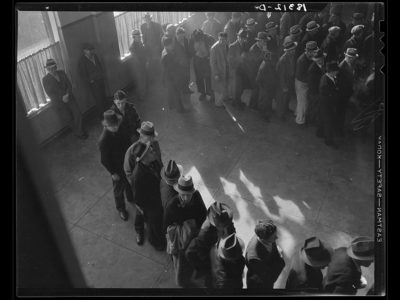Quality by-name data is an essential source of information that drives and informs efforts to make homelessness rare, brief, and nonrecurring within a community. Quality by-name data refers to a comprehensive data set of every person in a community experiencing homelessness, updated at least monthly. This data enables communities to easily see and understand who is experiencing homelessness and to drive what are called case conferencing meetings, where providers work together to match individuals and families with housing solutions that can meet their needs.
Additionally, communities with quality by-name data can track changes in the size and composition of the population experiencing homelessness, understand dynamics like inflow and outflow, and assess progress towards functional zero – an ongoing state where homelessness is rare and brief.
Through its work with more than 100 communities, Community Solutions has identified four components of quality by-name data systems:
- effective outreach systems
- homeless service provider participation
- policies and procedures
- robust data infrastructure
While each component is important, an effective and efficient data infrastructure serves as the foundation for quality by-name data.
This case study focuses on data infrastructure — the technologies and systems for data entry, storage, analysis, and sharing that support a community’s ability to use by-name data. The Homeless Management Information System (HMIS) is the backbone of this infrastructure in nearly all communities in Built for Zero. We explore how three communities use HMIS to gather, manage, and utilize their by-name data.
The Use of Homeless Management Information Systems for By-Name Data
Communities rely on the Homelessness Management Information System (HMIS) to gather data on people experiencing homelessness and services they’ve received. HMIS is an electronic data system managed locally, storing individual-level information about individuals accessing support from the homeless response system. The data collected through HMIS is intended to be analyzed to aid in program evaluation, planning, and funding requests. Aggregate HMIS data is also used by the U.S. Department of Housing and Urban Development (HUD) and federal partners to inform homeless policy and decision-making.1 HUD has required all federally funded homeless service programs to implement HMIS since 2004, when HUD published the Homeless Management Information System Data and Technical Standards.2
While HUD defines standards for HMIS data collection, privacy, and security that must be met by programs that receive federal funding, a single, standardized software program was not developed for use across all jurisdictions. Rather, private vendors develop HMIS software applications,3 and communities contract with private vendors for their HMIS software, customer support, and technical modifications. While this provides flexibility, it also places responsibility on communities for ensuring compliance with HUD’s standards and poses challenges for sharing HMIS learnings and innovation across communities.
After working closely with communities for eight years, Community Solutions has observed that many communities struggle to effectively leverage HMIS data to drive reductions in homelessness. For example, a 2017 survey of 36 Built for Zero communities conducted by Community Solutions found that less than a third of respondents (29%) indicated their HMIS reported out all the information needed to end homelessness in their communities, while only 43% of respondents felt their HMIS collected all the information they needed. Community Solutions has seen many communities struggle to leverage HMIS data for collecting the comprehensive, up-to-date data they need to effectively reduce homelessness. Challenges include incomplete data reporting, limited software functionality, costs, and technical expertise.
Despite these hurdles, some communities have found ways to succeed in using HMIS to collect real-time, by-name data and track system-level performance over time. These communities demonstrate that accessing and using quality by-name data with existing HMIS data systems is possible with collective willpower, steadfast efforts, and conditions in place to support the process. These experiences also highlight, however, the need for more by-name-data-friendly HMIS infrastructure for communities at-large.
Community Solutions has learned that communities typically approach the process of extracting by-name data from HMIS in one of two ways, as outlined below.
Two Approaches for Pulling By-Name Data from HMIS

Casting the Net Wide, or a decentralized approach, involves pulling data on individuals from multiple program types in HMIS. This approach works well in communities that do not use one specific program to track all individuals who connect with the homeless response system, including those who are still working to implement a Coordinated Entry system.

A Streamlined approach entails pulling data on individuals from a single program in HMIS. This approach works well for communities that use one program – typically, Coordinated Entry – to track all individuals moving through the homeless response system.
Community Case Studies
Community Solutions spoke with data leads in three Built for Zero communities in March 2023 to gain insight into their data systems and processes for accessing and utilizing by-name data, and how these have evolved over time. While their systems and approaches may not be directly transferable to all communities, our aim is to provide examples of how communities are able to extract critical data from their HMIS to generate their by-name lists, coordinate community resources, set goals, and measure system improvement.
Conversations focused on:
- The community’s HMIS software system, including its capabilities, the data lead’s experiences using the product, any challenges preventing communities from fully leveraging their HMIS data, and the various solutions they have implemented in response to these challenges.
- The community’s process for pulling by-name data from HMIS for various purposes, including generating by-name lists for case conferencing, calculating inflow and outflow, producing monthly Built for Zero reporting metrics, and/or monitoring system trends and performance to inform system improvement strategies.
- Practices for integrating data into HMIS from local Veterans Affairs medical centers, who provide housing programs and supportive services for veterans experiencing or at risk of homelessness.
- How the team handles data-related roles, responsibilities, and staffing.
Below, we present relevant background on each community and describe highlights and trends that emerged across community experiences.
Valley Homeless Connection, Virginia
● Part of Virginia Balance of State serving an area that has a population of over 150,000
● Serves Waynesboro, Staunton, Lexington, Augusta County, Rockbridge County, and Highland County
● Primarily rural with pockets of urbanization
● Joined Built for Zero in 2018
● Achieved quality by-name data for veterans experiencing homelessness in 2019
Metro Denver, Colorado
● The Metro Denver Homeless Initiative (MDHI) serves as the CoC, which covers a large, seven-county region with 40 municipalities and a population of 3.2 million
● CoC uses a sub-regional approach, with Homeless Coordination Teams across nine subregions focused on improving processes and securing resources to reach functional zero
● Joined Built for Zero in 2015
● Achieved quality by-name data for veterans experiencing homelessness in 2016
Charlotte-Mecklenburg County, North Carolina
● CoC includes individuals and organizations across Mecklenburg County, a municipality with a population of 1.14 million people
● Joined Built for Zero in 2015
● Achieved quality by-name data for chronic homelessness in 2016
● Achieved quality by-name data for veterans experiencing homelessness in 2018
Community Experiences
All three communities use HMIS as the primary source for their by-name data, but their software systems, experiences, and processes vary. Across community contexts, challenges arise in utilizing built-in reporting tools and functionalities in their HMIS software, and all three communities have had to supplement these with additional reporting tools and custom reports to generate by-name data. Rooted in an understanding of the importance of technology and data to drive reductions in homelessness, these communities demonstrate that accessing and using quality by-name data with existing HMIS data systems is possible with collective willpower, steadfast efforts, and conditions in place to support the process. These experiences also highlight, however, the need for more by-name-data-friendly HMIS infrastructure for communities at-large.
HMIS Software and Utilizing HMIS to Source By-Name Data
The Metro Denver Homeless Initiative (MDHI) transitioned to using a new HMIS software vendor in January 2019. After a lengthy process of identifying solutions and migrating HMIS software vendors over the course of several years, the team is highly satisfied with their current software, which is functional, robust, and allows for customization. Yet the rapid growth of their new HMIS software company caused some growing pains, including performance issues with the reporting tool. The Metro Denver team felt they had outgrown the software’s existing reporting infrastructure, which limited their ability to take advantage of the data they had collected. To address this, they purchased an additional reporting tool from their vendor that has a live, real-time SQL connection to the back-end of the database. MDHI takes a streamlined approach to extract by-name data from HMIS, pulling HMIS data from a single anchor program, the Coordinated Entry By-Name List Project for veterans.
The Charlotte-Mecklenburg Continuum of Care (CoC) recently transitioned in July 2023 to the same HMIS software vendor used in Metro Denver. Prior to the transition, Charlotte-Mecklenburg used the same software vendor that Valley Homeless Connection currently uses. Both Valley Homeless Connection and Charlotte-Mecklenburg have faced challenges in utilizing this software’s built-in reporting tools and functionalities to generate by-name data. While the software’s reporting platform allows users to create reports of all types in addition to the pre-loaded reports, many communities do not have a local staff person with the technical expertise or capacity to use the platform in this way.
Fortunately, Valley Homeless Connection and Charlotte-Mecklenburg have been able to use the Built for Zero Inflow, Outflow, and Case Conferencing Reports4 to generate by-name data from their HMIS systems. These reports produce a variety of lists – including people currently experiencing active homelessness, individuals who have entered the homeless response system during a reporting period, and individuals who have exited the homeless response system within a reporting period and the length of time taken for them to move into permanent housing. Without these reports, neither community had a clear method available for pulling by-name information out of HMIS that was not highly tedious and unsustainable.
Charlotte-Mecklenburg uses a casting-the-net-wide approach to pull data from multiple program enrollments in HMIS, including Emergency Shelter, Transitional Housing, Street Outreach, Permanent Housing, and Coordinated Entry projects. They include a range of projects to ensure that their by-name data captures everyone who has touched the homeless response system, including those who have not undergone a coordinated entry assessment. Valley Homeless Connection also currently uses a casting the net wide approach for pulling data from HMIS. In the near future, Valley Homeless Connections hopes to move to a streamlined approach and pull data exclusively from their Coordinated Entry project in HMIS.
While Valley Homeless Connection successfully uses HMIS to generate and use by-name data, the community continues to face frustrations with their current software. Their team has not been able to take advantage of their software vendor’s new reporting tool due to a lack of training on how to navigate the interface or utilize new functionalities.
Charlotte-Mecklenburg also felt limited by their previous HMIS software’s reporting tool. For this reason, the CoC contracted with a Community Solutions consultant to develop custom reports, which proved to be effective in meeting their specific needs for several years. With the recent transition to a new HMIS software, the Charlotte-Mecklenburg CoC is excited to further leverage technology and data to drive their efforts to reduce homelessness.
Integrating Data from Veterans Affairs Medical Centers
Although the sharing of data between HMIS and Veterans Affairs (VA) data systems is supported by both HUD and federal VA policy,5 data integration remains a challenge for many communities. We highlight how each community works with VA medical centers to integrate data on veterans experiencing homelessness within their community into HMIS.
Prior to the HMIS vendor migration in Metro Denver, the community’s veteran by-name list was stored and managed in a spreadsheet that was owned by the Rocky Mountain Regional VA Medical Center. Care coordination between providers and programs providing housing assistance and support services to veterans experiencing homelessness involved sharing encrypted spreadsheets to a formalized database. Additionally, MDHI had to manually calculate the metrics needed to reach a comprehensive and up-to-date understanding of the number of veterans actively experiencing homelessness, as well as the sources of inflow and outflow that contribute to that number. After Metro Denver transitioned to the new software vendor, MDHI and VA were able to co-design and operationalize procedures for data entry, sharing, and verification. Through a collaborative process, Metro Denver moved their veteran by-name list process into HMIS. VA staff now have direct access to enter data, review veteran activity, and verify the data with their internal database for quality assurance.
The Veterans Affairs (VA) medical center based in Salisbury, North Carolina, utilizes an Excel spreadsheet, referred to as “the tracker,” to share data with the Charlotte-Mecklenburg CoC. The spreadsheet contains specific data elements pertaining to homeless individuals, including their county of residence to ensure that the individuals are within the Continuum of Care’s jurisdiction, as well as their housing status and referral information. A VA Coordinated Entry Specialist at the Salisbury VA Medical Center sends an encrypted email to share this data with the Charlotte-Mecklenburg CoC on a weekly basis, and the CoC cross-matches this information against HMIS. For veterans on the tracker who are not currently in HMIS, the CoC enters their information in their Veteran By-Name List Project in HMIS. This process enables the CoC to maintain up-to-date information that facilitates their efforts to provide effective services to veterans experiencing homelessness.
VA medical centers near the Shenandoah Valley region complete Valley Homeless Connection’s universal intake form and Valley Homeless Connection enters their data into HMIS. As the closest VA medical center that serves their area is about 90 minutes away from Staunton, veterans in the region most often access Coordinated Entry directly at any of the regional access points in the region.
Data-Related Roles and Responsibilities
Although a small number of team members share data-related responsibilities across these communities, they make a large impact.
Until recently, MDHI in Metro Denver had two people on staff with data-focused roles: a Data Design & Reporting Lead and a Data Analyst. Considering their limited staff capacity, there is a constant eye towards sustainability and efficiency. The team has configured their data sources in a Tableau Server to securely and easily share their data via dashboards and reports across agencies, and they are working on automating the process.
Matt Richard, the lead in Metro Denver, noted that he is interested in streamlined workflows: “Whatever efficiency we can get – even if it saves me five minutes a day for something. It ultimately adds up.” Fortunately, the MDHI team recently expanded their data team to three members with the addition of a new Data Analyst, who they were able to hire with funding support from Community Solutions.
Valley Homeless Connection has two staff members, a Community-Based Services Manager and a Special Needs Housing Supervisor, with HMIS reporting licenses who share the workload of generating reports to create by-name lists for the region’s four focused case conferencing meetings. Lydia Campbell, the lead at Valley Homeless Connection, has focused on ensuring sustainability by creating detailed plans for her eventual exit from her role. Her planning has contributed to shared accountability, and her leadership serves as a strong example for other organizations to prepare for the future and ensure key responsibilities are documented and understood.
In Charlotte-Mecklenburg, the CoC’s HMIS and Research Team has four staff members. One member, who serves as a Senior Management Analyst and HMIS Administrator, is responsible for policy and data support within the community. One Management Analyst concentrates on training and technical assistance, and another Management Analyst focuses on federal reporting. A new Senior Management Analyst was recently hired to assist with the CoC’s HMIS software migration.
Using Quality By-Name Data for System Improvement
A common thread weaves through approaches in Metro Denver, Valley Homeless Connection, and Charlotte-Mecklenburg: the harnessing of high-quality by-name data to reduce and end homelessness. These communities embrace the pivotal role of data in steering their efforts to design systems that can ensure homelessness is rare and brief.
Metro Denver’s MDHI generates monthly metrics through strategic coordination across their CoC. As a result, they are able to produce a list of veterans that the Rocky Mountain Regional VA Medical Center can review to swiftly determine VA resource eligibility. This collaborative approach ensures that homeless veterans are connected more quickly to housing and vital services. Beyond this, the by-name data empowers MDHI to gauge system performance accurately. It’s this data-driven insight that guides both regional and local efforts to combat homelessness effectively.
In the Shenandoah Valley region, Valley Homeless Connection has been able to use their by-name data to facilitate case conferencing meetings, identify community needs, and advocate for additional housing programs and resources. The team has successfully established several new programs in the region, including a permanent supportive housing program, a rapid rehousing program, and a street outreach program. As additional programs have been developed and new partners are joining community-wide efforts to end homelessness in the region, Valley Homeless Connection has established a strong culture of using HMIS and uses by-name lists generated by reports in HMIS to drive case conferencing meetings. Their case conferencing meetings have grown tremendously, with various partners at the table, including new non-profit outreach programs, social services, the Shenandoah LGBTQ Center, Supportive Services for Veteran Families, and community health workers. Case conferencing has now grown and become so successful that what was first one large session has split into four focused meetings dedicated to specific prioritized by-name lists: chronic, veteran, youth, and unsheltered.
The Charlotte-Mecklenburg CoC approaches data as a guiding compass. Their quarterly scrutiny of inflow data paints a vivid portrait of those entering the homeless response system. This meticulous examination reveals trends over time and informs the allocation of precious resources. Data isn’t confined to backrooms; it’s integral to every CoC committee, including the Equity & Inclusion Committee. Monthly dives into disaggregated data spotlight areas needing attention. Furthermore, they don’t keep these insights locked away – a dynamic data dashboard accessible to the public chronicles shifts in homelessness numbers over time, carefully broken down by age, gender, race, and ethnicity.
Conclusion
Having access to quality by-name data is pivotal in reducing and solving homelessness. The value of solving these issues is clear. By using quality by-name data, these communities have made informed decisions, prioritized resources, and worked towards reducing homelessness. Their stories serve as models for other communities aiming to leverage data for better outcomes in the fight against homelessness.
The experiences of these communities show there are many challenges in functionality, capacity, and tools that must be overcome to fully leverage HMIS data. However, communities demonstrated that many barriers may be challenging but not insurmountable, seeking additional solutions like custom reports and additional reporting tools. They have also invested in data roles and responsibilities, ensuring the necessary skills and expertise are in place to use the data.
The experiences of these communities also underscore the need for ongoing efforts to improve HMIS infrastructure and support communities in maximizing the potential of by-name data. Standardizing reporting tools and functionalities, enhancing training and technical support, and promoting data sharing and integration across different systems are areas that require attention. Moreover, further support and solutions are needed to support integrating data from Veterans Affairs medical centers into HMIS, which poses ongoing challenges for data sharing and coordination.
Continued investment in data infrastructure, collaboration, and innovation can catalyze and accelerate progress in ending homelessness. With collective willpower, dedication, and an ongoing commitment to innovation, communities can work towards achieving functional zero, where homelessness becomes rare, brief, and nonrecurring.
Footnotes
1HUD, 2023. HMIS Requirements.
2HUD, 2022. Introduction to HMIS Data Standards.
3For details on the BFZ Quality By-Name Data criteria, please visit this website: https://community.solutions/quality-by-name-data/
4The link provided is to a manual developed by Community Solutions that describes how to use the most up to date version of the BFZ reports, the v4.11 report suite, as a reference for readers interested in these reports. As the v4.11 report suite was recently released, communities in the current case study were utilizing previous versions.
5See U.S. Department of Veterans Affairs Homeless Program Office’s Policy Q&A on VA Guidance on HMIS “Read-Only” and “Direct-Entry” Access. Also see Routine Use of Records Maintained in the System #30 in the “Privacy Act of 1974; System of Records,” Federal Register Doc. 2018–02760.




